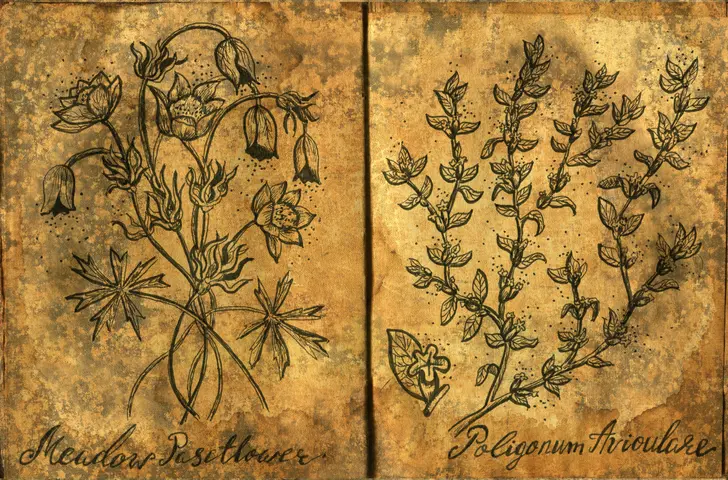Books are meant to enlighten, inform, and entertain. And yet, there are those that perplex, bewilder, and defy explanation. Whether due to their bizarre content, unknown origins, or inscrutable writing system, these texts remain undeciphered.
So, what’s the story behind each of these literary enigmas? Are they elaborate hoaxes? Forgotten knowledge? Or simply something we have yet to understand? Library cards at the ready, because we’re checking them out.
The Voynich Manuscript

An ancient text similar in it's peculiarity to the Voynich Manuscript (Credit: VeraPetruk via Getty Images)
Acquired in 1912 by antiquarian bookseller Wilfrid Voynich, this 15th-century manuscript is one of the most perplexing literary puzzles in history. Spanning 234 pages, it’s filled with enigmatic writing and haunting illustrations. The artwork ranges from depictions of unidentifiable plant species and intricate astronomical charts to abstract shapes and mysterious figures.
The text itself is written in an entirely unknown script, nicknamed Voynichese, which has defied all attempts at translation. Despite the efforts of linguists, cryptographers, and even artificial intelligence, no one has successfully extracted its meaning. Some speculate that the manuscript is a sophisticated hoax, while others believe it could be a lost alchemical or medicinal text. With no known author, no historical references, and a writing system seen nowhere else, the Voynich Manuscript remains one of the greatest unsolved mysteries of the literary world.
The Book of Soyga

The Book of Soyga resurfaced at the Bodleian Library in Oxford in 1994 (Credit: Aiselin82 via Getty Images)
The Book of Soyga is a 16th-century manuscript of unknown origin detailing magical lore, astrological calculations, angelic language, and cryptic symbols. Mostly written in Latin, it also contains many instances of backwards writing and mysterious ciphers. It’s famed for its connection with renowned Elizabethan scholar and occultist John Dee, who was intrigued by the manuscript’s mystical significance and determined to unravel its meaning. As part of this, he reportedly consulted angels through his medium Edward Kelley, but never achieved his goal.
After Dee’s death, the book was seemingly lost, with no other known copies. It was only in 1994 that the Book of Soyga resurfaced in the British Library and the Bodleian Library, reigniting scholarly fascination. Researchers speculate the manuscript served as a guide to rituals, astrology, or even coded divine knowledge. The book’s complexity, featuring letters arranged in seemingly impenetrable patterns, continues to puzzle modern cryptographers and historians alike.
The Rohonc Codex

The Rohonc Codex depicts strange military and religious scenes (Credit: Shi Wei via Getty Images)
Another baffling book is the Rohonc Codex, a handwritten manuscript discovered in Hungary in the 19th century. Its pages contain an undeciphered script written from right to left, interspersed with strange illustrations depicting religious and military scenes. The symbols bear no resemblance to any known alphabet, and no other document has been found that uses the same writing system.
Some believe the Rohonc Codex is a medieval religious text, while others think it might be an elaborate forgery designed to confuse scholars. Despite numerous attempts, no one has conclusively identified its language, author, or purpose.
The Codex Seraphinianus

The Codex Seraphinianus is full of drawings of plants, creatures and machines (Credit: VeraPetruk via Getty Images)
Onto the most modern entry on this list, the Codex Seraphinianus was created in 1981. The work of Italian artist Luigi Serafini, this lavishly illustrated book is written in an entirely invented language, complete with its own grammar and syntax.
Filled with surreal imagery of bizarre creatures, plants, and machines, the Codex appears to be an encyclopedia from an alternate reality. While Serafini has admitted that the script has no actual meaning, he designed it to evoke the feeling of reading a book in a language one does not understand. This intentional mystique has kept the Codex Seraphinianus a cult favourite among bibliophiles and lovers of the bizarre.
The Codex Gigas

The Codex Gigas is housed in the National Library of Sweden in Stockholm (Credit: tupungato via Getty Images)
Weighing roughly the same as an adult kangaroo and nearly three feet long, the Codex Gigas is one of the largest medieval manuscripts ever created. But it’s not just its size that’s unsettling. Inside, alongside the complete Latin Bible, is a full-page illustration of the devil, leading to sinister legends about its origins.
According to one tale, the book was written in a single night by a monk who made a pact with Satan. While historians believe it was actually written over decades, the legend only adds to its eerie reputation. Today, the Codex Gigas is housed in Sweden’s National Library, where it continues to fuel speculation and superstition.
Beowulf

Beginning of the first folio of the heroic epic poem Beowulf (Credit: ZU_09 via Getty Images)
One of the greatest works of Old English literature, Beowulf is an epic poem that has fascinated scholars for centuries. Believed to have been composed between the 8th and 11th centuries, it tells the heroic tale of Beowulf, a warrior who battles the monstrous Grendel, Grendel’s vengeful mother, and later, a fearsome dragon.
Despite its literary significance, Beowulf remains shrouded in mystery. The poem’s origins, authorship, and historical accuracy are all subjects of debate. Was it passed down through oral tradition before being written? Is it at least partly based on real events or purely legend? And why does only one surviving manuscript exist? Discovered in the 18th century and nearly destroyed in a fire, the manuscript continues to intrigue literary historians, leaving many questions unanswered.
The Smithfield Decretals

The Smithfield Decretals contain the papal decrees of Pope Gregory IX (Credit: ilbusca via Getty Images)
The Smithfield Decretals is a 14th-century collection of papal decrees which, at first glance, seems like an ordinary medieval manuscript. However, upon closer inspection, its margins reveal an astonishing array of bizarre and sometimes disturbing illustrations. From knights battling giant snails to grotesque hybrid creatures, the book is filled with strange imagery that appears unrelated to the text.
Historians are uncertain why such odd drawings were included in a formal manuscript, leading some to believe they had hidden meanings or were simply a medieval scribe’s creative indulgence. The mystery of its whimsical and often macabre artwork remains unsolved.
Shakespeare’s Lost Play

The Plays of Shakespeare (Credit: duncan1890 via Getty Images)
Among the many mysteries surrounding William Shakespeare, one of the most intriguing is that of the lost play Cardenio. Believed to have been performed in 1613 and attributed to Shakespeare and fellow playwright John Fletcher, no known copies of the script have ever been found. So, what happened to it? Scholars have debated whether fragments of Cardenio survive in later adaptations or if the play was simply lost to time. Some even speculate that it may one day be rediscovered. Until then, this remains one of the greatest missing pieces in Shakespearean literature.
The Dead Sea Scrolls

The Dead Sea Scrolls (Credit: tzahiV via Getty Images)
Perhaps one of the most significant discoveries of the 20th century, the Dead Sea Scrolls were found in caves near the Dead Sea in the 1940s and 50s. These ancient Jewish texts, dating from the 3rd century BC to the 1st century AD, include copies of biblical books as well as previously unknown writings.
While some scrolls have been translated, others remain puzzling, and debates over their authorship and purpose continue. Some theories suggest they were created by a sect known as the Essenes, while others argue they represent a broader collection of early Jewish writings. The full story behind these sacred texts may never be fully uncovered.
The Final Chapter

There's much we still don't know... (Credit: Tetra Images via Getty Images)
In conclusion, these strange and unexplained books serve as reminders of how much we have yet to understand about history, language, and creativity. Whether filled with indecipherable scripts, eerie illustrations, or forgotten knowledge, each of these literary mysteries continues to spark curiosity and intrigue. As technology advances, perhaps some of these books will finally reveal their secrets. Until then, they remain enigmatic testaments to the mysteries of the past.











